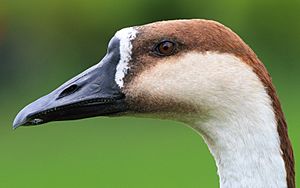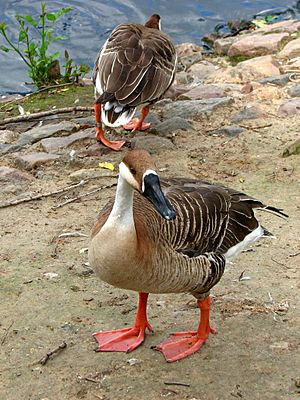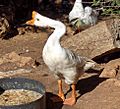Swan goose facts for kids
The swan goose (Anser cygnoides) is a large type of goose that lives naturally in parts of Mongolia, northern China, and southeastern Russia. These geese are migratory, meaning they fly to warmer places for winter, mainly in central and eastern China. Sometimes, they can be seen in other countries like Japan and Korea, where they used to spend winters more often.
While you don't see many swan geese in the wild, some have been domesticated by humans. You can find these domestic versions, like the Chinese goose and African goose, in many places outside their natural home. Wild swan geese are also kept in special collections, and sometimes they escape and join other groups of geese.
Quick facts for kids Swan goose |
|
|---|---|
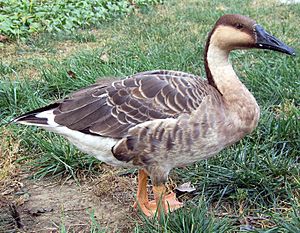 |
|
| Anser cygnoides cygnoides in China | |
| Conservation status | |
| Scientific classification | |
| Genus: |
Anser
|
| Species: |
cygnoides
|
| Subspecies | |
|
A. c. cygnoides (Linnaeus, 1758) |
|
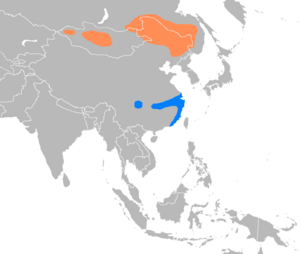 |
|
| Breeding (northern areas) in orange and wintering (southern areas) ranges in blue | |
| Synonyms | |
|
|
Contents
What Does a Swan Goose Look Like?
The swan goose is a big bird with a long neck, especially for its type of goose. Wild swan geese are usually about 81–94 cm (32–37 in) long. This makes them the longest geese in their group. They weigh around 2.8–3.5 kg (6.2–7.7 lb) or more.
Both male and female swan geese look similar, but the male is usually bigger. Males also have a longer bill (beak) and neck. The largest females are only about the size of the smallest males. An adult goose's wingspan (how wide its wings are when spread out) is about 160–185 cm (63–73 in).
Their upper parts are brownish-grey. They have a maroon (reddish-brown) color on the back of their neck and on their head, reaching just below their eyes. Their wing feathers are blackish, and the feathers under their wings are also black. Their tail feathers are black with white tips.
A thin white stripe goes around the base of their bill. Their underside is a pale, creamy color, especially light on their lower head and front of the neck. This light color is clearly separate from the maroon on their upper neck. When they fly, their wings look dark without any special patterns.
Unlike other geese in its group, the swan goose has a long, heavy bill that is completely black. Their legs and feet are orange, like many of their relatives. Their eyes are maroon. Young swan geese (called juveniles) are not as brightly colored as adults. They also don't have the white stripe at the base of their bill or the dark streaks on their underside.
The swan goose makes a loud, long, and rising honking sound, like aang. When they want to warn others, they make a similar but more barking honk two or three times quickly.
Where Do Swan Geese Live and What Do They Do?
Swan geese live in areas from steppe (grassy plains) to taiga (forests) and mountain valleys near freshwater. They mostly eat plants like sedges (grass-like plants) and don't swim very often. Outside of the breeding season, they form small groups. In winter, they eat plants in open fields, sometimes far from water.
These birds return from their winter homes around April, and the breeding season starts soon after. They build nests as single pairs or in loose groups near marshes and other wetlands. Nesting usually begins around May. A female goose typically lays 5 to 6 eggs, but sometimes up to 8. The eggs are laid in a shallow nest made from plants, placed directly on the ground. Often, the nest is on a small hill to keep it dry.
The young geese hatch after about 28 days. They are precocial, meaning they are quite developed and can move around shortly after hatching. They become old enough to have their own babies when they are 2 to 3 years old. Around late August or early September, the geese fly to their winter homes. There, they gather in small groups to moult, which means they shed their old feathers and grow new ones.
Why Are Swan Geese Vulnerable?
The swan goose is currently listed as a Vulnerable species on the IUCN Red List. This means their population is decreasing. This is happening because their homes (habitats) are being lost, and too many are being hunted. Also, in some areas like the Sanjiang Plain in China, people collect their eggs too much.
New studies have shown that there might be more swan geese than previously thought, so their status was changed from "Endangered" back to "Vulnerable" in 2008. Still, there might be less than 500 pairs left in Russia. In Mongolia, the exact numbers are not known, but about 1,000 were seen at Ögii Lake in 1977.
Favorite wintering spots in China include Lake Dongting, Lake Poyang, the Yancheng Coastal Wetlands, and other places around the lower Yangtze River. About 60,000 swan geese can be found there each year, which might be almost the entire world population. In the past, until the 1950s, some swan geese used to spend winters in Japan, but habitat destruction has made them leave. Overall, there are estimated to be between 60,000 and 100,000 adult swan geese left in the wild today.
How Swan Geese Became Domesticated
Most domestic geese we see today come from the greylag goose. However, two types of domestic geese, the Chinese goose and the African goose, are direct descendants of the swan goose. People have been domesticating these geese since at least the mid-1700s, and possibly even as far back as 1000 BC in China.
These domestic breeds look quite different from their wild relatives. They also have different personalities and are better at producing meat and eggs. The most noticeable difference is the large bump (called a bill knob) on their beak and their upright way of standing.
Charles Darwin, a famous scientist who studied evolution, looked at different goose breeds. He noticed that even though Chinese geese and greylag geese looked very different, they were actually closely related. He observed that their mixed offspring could sometimes have babies with either pure parent, and even with each other in one case. This showed a close connection between the species.
Gallery
-
A gosling of swan goose in Bangladesh
See also
 In Spanish: Ánsar cisnal para niños
In Spanish: Ánsar cisnal para niños



